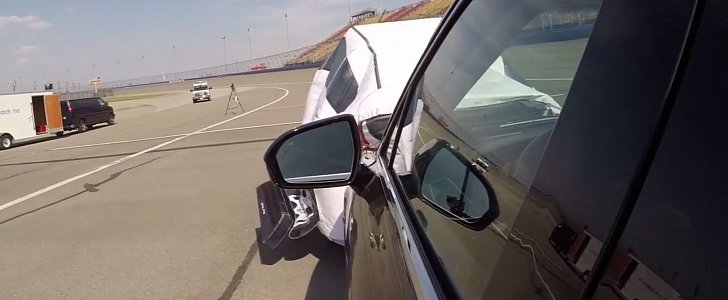Autonomous emergency braking (AEB) and the fancier advanced emergency braking system (AEBS) are the next big thing in vehicle safety. The NHTSA and Euro NCAP both praise auto-braking systems, but the AAA has a different say-so on this technology that’s slowly but surely becoming standard in passenger cars.
The American Automobile Association notes that AEB systems “vary widely in design and performance.” As a consequence of the fact not all auto-braking system are created equal, the AAA wants car buyers to know that AEBs “are not all designed to prevent collisions and urges consumers to fully understand system limitations before getting behind the wheel.” You’ve been warned.
In the adjacent clip, the peeps over at the AAA have tested five cars from model year 2016: Volvo XC90, Lincoln MKX, Subaru Legacy, Honda Civic, and Volkswagen Passat. Of course, the testing has been done to verify exactly how each vehicle’s auto-braking system reacts in the event of a crash.
The AAA highlights that each passenger vehicle in its test is equipped with one of two systems: it's either collision avoidance or collision mitigation.
As a rule of thumb, keep in mind that the collision avoidance system is designed in such a way that the car tries to avoid a crash with an object or car ahead of it by jumping on the brakes as hard as possible. A collision mitigation system, however, doesn’t prevent the imminent crash. In fact, it can only slow the vehicle down to reduce the damage of the accident.
After checking the owner’s manuals, the AAA found that the Volvo, Subaru, and Lincoln are equipped with collision avoidance systems, while the Honda and Volkswagen are only able to mitigate a crash. And now, prepare for the stone cold truth: “After more than 70 trials, tests reveal” that “in terms of overall speed reduction, the systems designed to prevent crashes reduced vehicle speeds by twice that of systems that are designed to only lessen crash severity (79 percent speed reduction versus 40 percent speed reduction).”
And naturally, as speed increases, both kinds of automatic braking systems lose most of their effectiveness. What can we learn from this, then? Here’s a top tip for you: never ever trust the mumbo-jumbo advertising of an automaker. Just ask the car salesman to show you what the AEB system can do by pointing out the system's description in the car's owner’s manual.
Last, but certainly not least, don’t forget that a vigilant driver is often better than a pre-programmed automatic braking system in these situations.
In the adjacent clip, the peeps over at the AAA have tested five cars from model year 2016: Volvo XC90, Lincoln MKX, Subaru Legacy, Honda Civic, and Volkswagen Passat. Of course, the testing has been done to verify exactly how each vehicle’s auto-braking system reacts in the event of a crash.
The AAA highlights that each passenger vehicle in its test is equipped with one of two systems: it's either collision avoidance or collision mitigation.
As a rule of thumb, keep in mind that the collision avoidance system is designed in such a way that the car tries to avoid a crash with an object or car ahead of it by jumping on the brakes as hard as possible. A collision mitigation system, however, doesn’t prevent the imminent crash. In fact, it can only slow the vehicle down to reduce the damage of the accident.
After checking the owner’s manuals, the AAA found that the Volvo, Subaru, and Lincoln are equipped with collision avoidance systems, while the Honda and Volkswagen are only able to mitigate a crash. And now, prepare for the stone cold truth: “After more than 70 trials, tests reveal” that “in terms of overall speed reduction, the systems designed to prevent crashes reduced vehicle speeds by twice that of systems that are designed to only lessen crash severity (79 percent speed reduction versus 40 percent speed reduction).”
And naturally, as speed increases, both kinds of automatic braking systems lose most of their effectiveness. What can we learn from this, then? Here’s a top tip for you: never ever trust the mumbo-jumbo advertising of an automaker. Just ask the car salesman to show you what the AEB system can do by pointing out the system's description in the car's owner’s manual.
Last, but certainly not least, don’t forget that a vigilant driver is often better than a pre-programmed automatic braking system in these situations.







